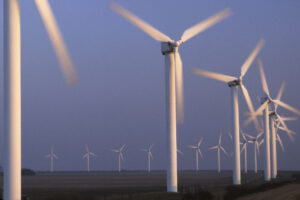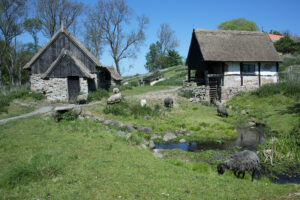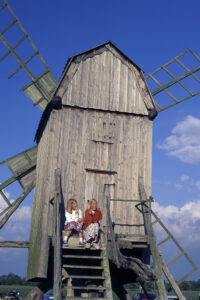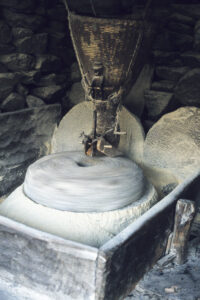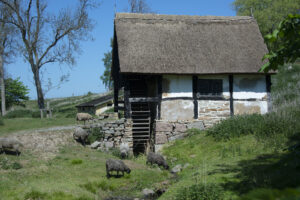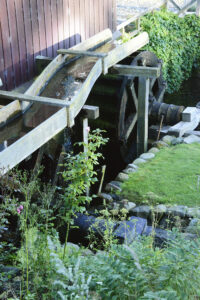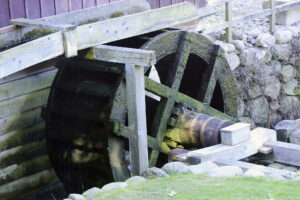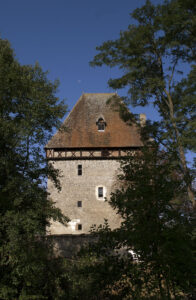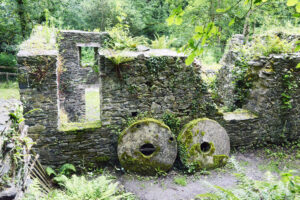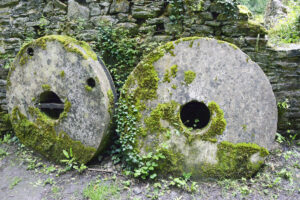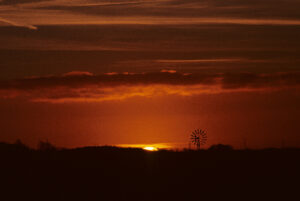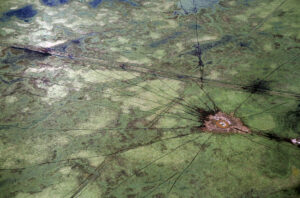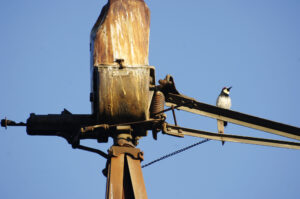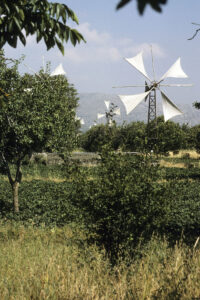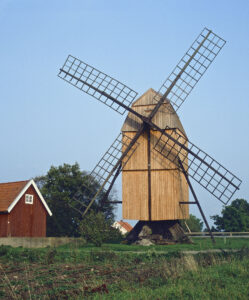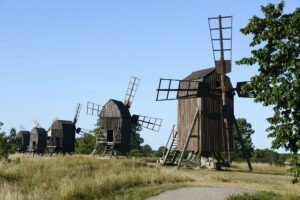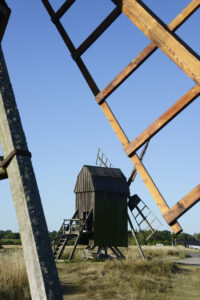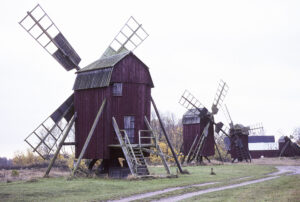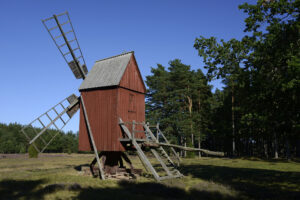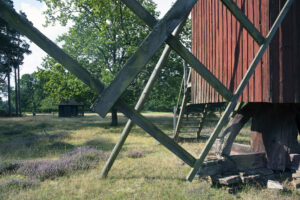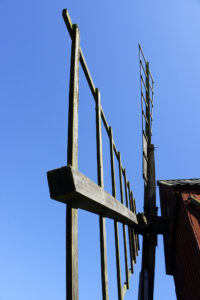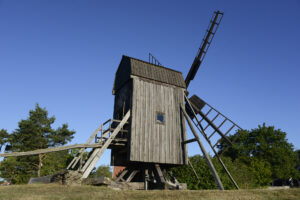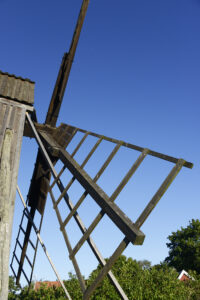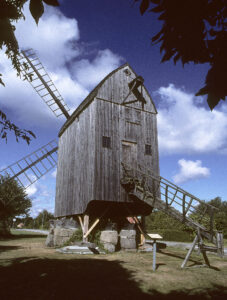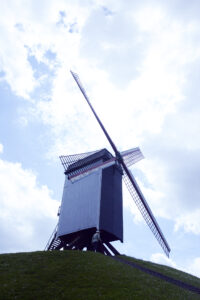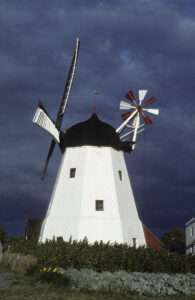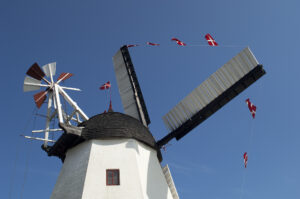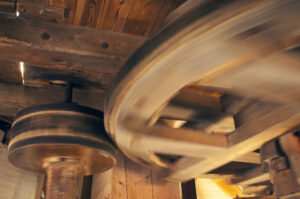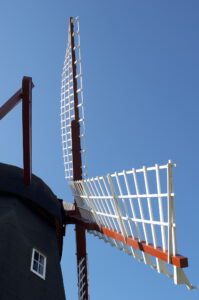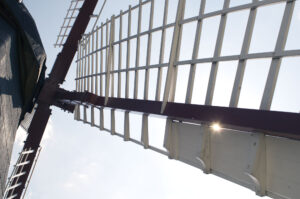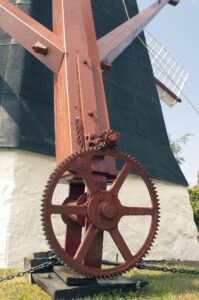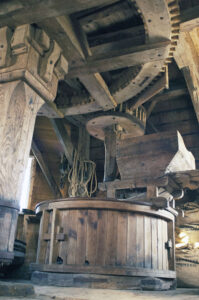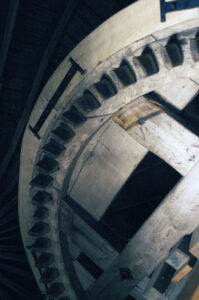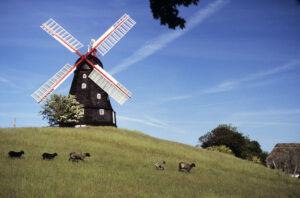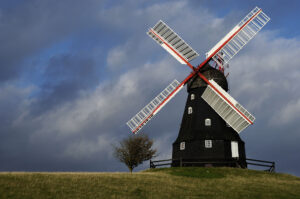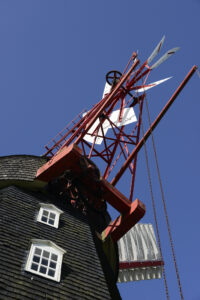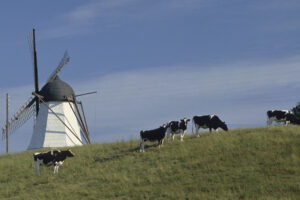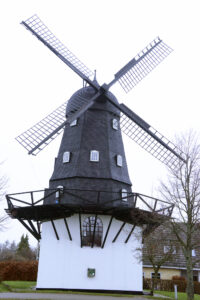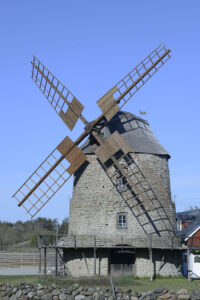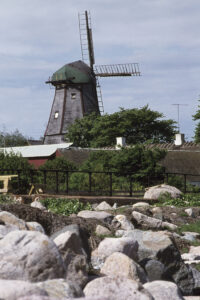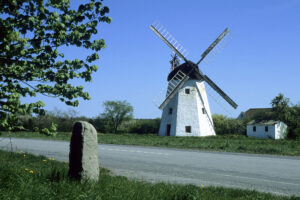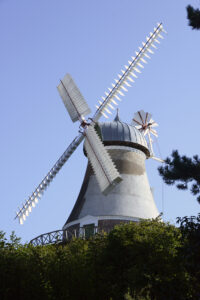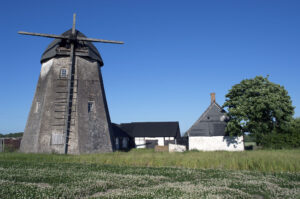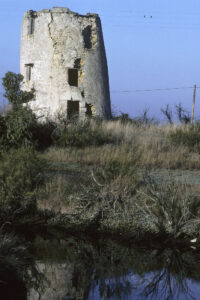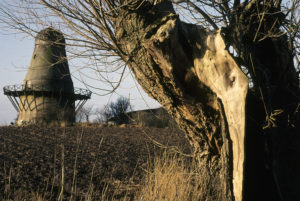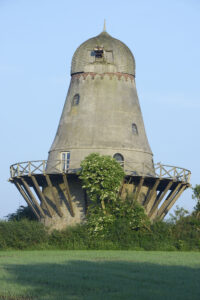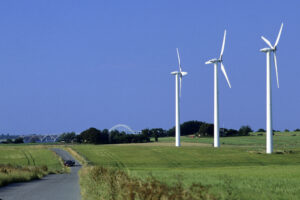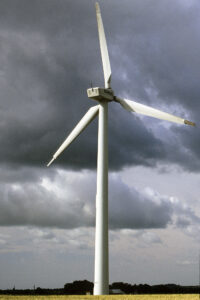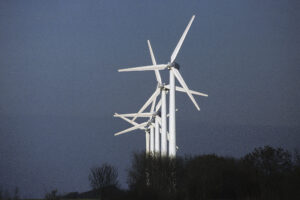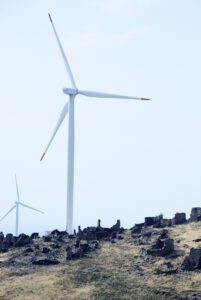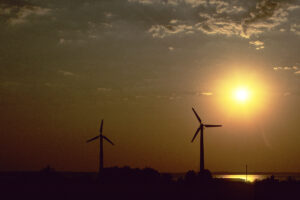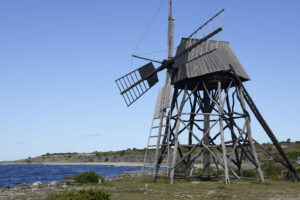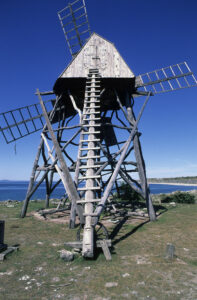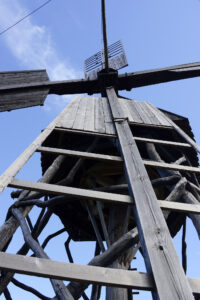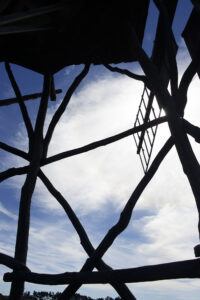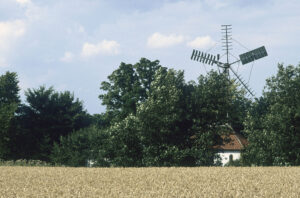Mills
Windmill park, Kappel, Lolland, Denmark. (Photo copyright © by Kaj Halberg)
Wings and windrose of Påø Mill, a Dutch type tower windmill, Langeland, Funen, Denmark. (Photo copyright © by Kaj Halberg)
Slusegård Watermill, southern Bornholm, Denmark. The wheel with buckets is seen behind two of the sheep. (Photo copyright © by Kaj Halberg)
Post mill, Himmelsberga, Öland, Sweden. (Photo copyright © by Kaj Halberg)
When our forefathers first learned to make flour from wild grasses, they probably just used a stone to crack the seeds on another stone. Archaeological evidence for making bread dates back to at least 12.000 B.C. (Source: Arranz-Otaegui, A. 2018. Archaeobotanical evidence reveals the origins of bread 14,400 years ago in northeastern Jordan. Proceedings of the National Academy of Sciences of the United States of America, 115 (31): 7925-7930)
Over time, the cracking stones evolved into true grinding stones, with a larger, flat and smooth stone, on which the corn was placed, and then using a round stone to crush the seeds.
Later, various types of mills were invented to perform the grinding of the cereals, divided into watermills, which work by hydropower, and windmills, which are driven by the wind.
Grinding stone from the Iron Age, with barley, displayed at Tappernøje, southern Zealand, Denmark. (Photo copyright © by Kaj Halberg)
Watermills
Far back in time, mills were constructed along streams, where the running water would turn one or more water wheels around. A number of wooden blades, or buckets, were fastened to the outside rim of the wheel all the way around. When the water fell on these blades, the wheel would turn around, and a mechanism attached to the wheel would turn large mill stones, which would mill (grind) the cereals. Later, water mills were used for production of many other goods, including timber, paper, textiles, and some metal items.
Watermills are divided into two types, one with an overshot wheel, where the water falls on the blades from above in the front part of the wheel, the other with an undershot wheel, where the water falls on the blades in the rear part of the wheel. Thus, the two types turn in opposite directions.
Grinding maize in simple water-driven mills, Jagat, Marsyangdi Valley, Annapurna (upper 2), and Nakote, Helambu, both in central Nepal. (Photos copyright © by Kaj Halberg)
Slusegård Watermill
This mill in southern Bornholm, Denmark, was constructed as an undershot mill in the early 1800s, whereas a building for trout breeding was constructed in the middle of the same century. The mill house is a half-timber construction with straw roof and has a single wheel. In the 1940s, the buildings were in a very poor condition, but restoring took place during the 1950s and 1960s. The wheel was replaced in 1989, and the quern is now functioning.
Slusegård Watermill. The wheel with buckets is seen behind two of the sheep. (Photo copyright © by Kaj Halberg)
Lillemølle
Lillemølle (‘Little Mill’) is an overshot type of watermill, beautifully situated along Ørbæk River, near Nyborg, eastern Funen, Denmark. It was built in 1672, but burned down in 1827, and a three-winged farm was constructed on the spot. Until 1900, the mill belonged to the Holckenhavn Estate. From 1764 to 1971, it was operated by six generations in the same family. Today, the mill is protected and in a very good condition, thanks to several restorations since 1970. It is still functioning, having two wheels.
Lillemølle has two wheels. (Photos copyright © by Kaj Halberg)
Batsto Mill
A mill has existed for more than 200 years in Batsto Village, Pine Barrens, New Jersey, United States. The current mill was established in 1882, replacing the water-powered equipment with a turbine-driven circular saw that is still in use today.
Today, the watermill in Batsto Village is a museum. (Photo copyright © by Kaj Halberg)
Mill stone at the watermill in Batsto Village. (Photo copyright © by Kaj Halberg)
Tour du Moulin-Neuf
It is not known, when the watermill in Chatel de Neuvre, southern France, was in operation. The present building was constructed as a fort in the 1300s on an island in a pond, which still surrounds it almost entirely. It is 36 m tall, divided into four stories. The fort was built to defend the region and to control crossing of the Allier River.
Tour du Moulin-Neuf. (Photo copyright © by Kaj Halberg)
This watermill in the city of Huelgoat, Brittany, was originally built in the 1500s, at that time having two wheels. (Photo copyright © by Kaj Halberg)
Mill stones in the abandoned watermill Moulin de la Mer, Brittany, which today lie in ruins. (Photos copyright © by Kaj Halberg)
Windmills
Simple windmills
At an early stage, simple windmills were constructed to pump up water for cattle and other domestic animals. The wind rose is a multi-bladed windmill, which was (and in some places still is) used to pump up water.
Wind rose at sunrise, near Skanderborg, Denmark. (Photo copyright © by Kaj Halberg)
Aerial photograph of a drinking trough for cattle, Værnengene, Ringkøbing Fjord, Denmark. As is evident from the picture, the cattle use the same tracks day after day. (Photo copyright © by Kaj Halberg)
This dilapidated wind rose in Ronald W. Caspers Wilderness Park, Santa Ana Mountains, California, was formerly used to pump up water for cattle. The bird is an acorn woodpecker (Melanerpes formicivorus), a common species, which is found from California through Mexico and Central America to northern Columbia. It is described in depth on the page Animals – Birds: Birds in the United States and Canada. (Photo copyright © by Kaj Halberg)
Wind roses with sails, Lassithi Plains, Crete, Greece. (Photo copyright © by Kaj Halberg)
Post mills
The post mill is the earliest type of true windmills in Europe. It is a wooden mill, characterized by the whole body of the mill being mounted on a single central vertical post, which is supported by four quarter bars. The entire structure usually rests on a foundation of stones.
The wind power is utilized most efficiently, when it is perpendicular to the wings of the mill. Therefore, the wings must be turned according to the direction of the wind, and on a post mill the entire body is turned around the central post from the ground, using a large pole, which is attached to the mill.
Post mills have four wings, each consisting of a long pole, on which transverse and longitudinal wooden strips have been attached. When the mill was in usage, sails were attached to the wings.
In the 1800s, about 2,000 post mills were found on the Swedish island Öland, but during the 1900s many went into decay and were torn down. However, no less than about 355 have been preserved, forming a characteristic feature on the island. The following 11 pictures are all from Öland.
Färjestaden. (Photo copyright © by Kaj Halberg)
A row of post mills, Lerkaka, near Runsten. (Photos copyright © by Kaj Halberg)
A row of post mills, Störlinge. (Photo copyright © by Kaj Halberg)
Glömminge. (Photos copyright © by Kaj Halberg)
Åkerby. (Photos copyright © by Kaj Halberg)
Vanserum. (Photo copyright © by Kaj Halberg)
Sunset behind a post mill, Albrunna. (Photo copyright © by Kaj Halberg)
Bech’s Post Mill
This mill in the town of Svaneke, Bornholm, Denmark, is the largest post mill on Bornholm, and maybe it is also the oldest mill in Denmark, erected 1629-1634. In 1866, it was renovated and mounted on a stone foundation. However, it does not rest on this foundation, but on 16 supporting beams. The mill was a grinding mill for cereals, and in 1857 a bakery was built nearby. Both were abandoned in 1928. The mill was protected in 1959, and in 2005 it got new wings.
Bech’s Post Mill. (Photo copyright © by Kaj Halberg)
Post mill, Brugge, Belgium. (Photo copyright © by Kaj Halberg)
Tower windmills
On windmills of this type, only the top part of the mill (the ‘hat’), on which the wings have been fastened, is turned according to the direction of the wind. This may be done from the ground, using a pole like with the post mill, or by a wind rose, a so-called fantail, attached to the hat on the leeward side. The wings often have blades, which can be regulated so that the wings always turn with the same speed, regardless of the wind strength.
The earliest mills of this type were invented around 1300. They were built of stone, which meant that they could be much taller and more solid than the post mills, allowing the wings to be longer and thus utilize the wind more efficiently.
Årsdale Mill
This Dutch type tower mill, near Svaneke, Bornholm, Denmark, was built in 1877, and grinding corn continued until 2003. My friend Søren Lauridsen writes about this mill: “Årsdale Mills is functioning as in the old days by wind power, and you ofte notice the wings turning. Grinding corn is no longer taking place, but you can enter the mill and observe how this age-old profession was carried out. The smell of flour sacks – and the dust – can give anybody a nostalgic flip about the time when not everything was sterile. The mill is an octangular white-washed tower mill in four stories. It has a 1 metre thick foundation, and the walls are covered in burned tiles to a height of 15 m. The onion-shaped hat is 5 m tall, made from oak wood and Swedish pine. Shingles and wings are made from larch. The fantail, which turns the hat, is from around 1920. Everything in the mill is intact and very well maintained.”
Årsdale Mill and dark rain clouds. (Photo copyright © by Kaj Halberg)
When this picture was taken, Årsdale Mill was working for the benefit of tourists, and small Danish flags had been attached to strings between the wings. (Photo copyright © by Kaj Halberg)
Interior mill wheels at work, Årsdale Mill. (Photo copyright © by Kaj Halberg)
Kuremøllen
This beautiful Dutch type windmill is situated near Svaneke, Bornholm, Denmark. It was built in 1861 to grind wheat and other crops, and a bakery was opened at the mill in 1912. The mill stopped working in 1960, whereas the bakery was closed in 1976. The mill was restored back to its original form in 2005, including poles to turn the hat from the ground. However, it is not done by hand, but with the help of a winch.
Kuremøllen. (Photos copyright © by Kaj Halberg)
Pole with a winch to turn the hat, Kuremøllen. (Photo copyright © by Kaj Halberg)
Interior of Kuremøllen. (Photos copyright © by Kaj Halberg)
Påø Mill
This mill, also known as Skovsgaard Mill, is found on the island of Langeland, Denmark. Two former mills on the place burned down. The original post mill from the 1600s burned down in 1834, and it is assumed that it was very small, as the insurance sum was only 400 Rigsdaler. A new mill was built, but that one also burned down, around 1900. Officially, the cause of the fire was that the mill had run very hot, but the miller was convinced that it was arson. He was wealthy, and he thought that he had been the victim of jealousy, especially as he had been receiving threats via letters.
The present mill was built in 1904. It is now protected and has been restored in 1984, and again in 2003, after a storm in 1999 tore off a wing and also caused other damage to the mill.
Påø Mill. (Photos copyright © by Kaj Halberg)
Langhammar Mill
This mill, found on the island of Fårö, Gotland, Sweden, was probably built in the early 1800s. The last grinding seems to have taken place around 1890. While the owner was in America for some years, the mill was rented by a farmer who let it fall into disrepair. It has since been restored, but nothing remains of the machinery.
Langhammar Mill. (Photo copyright © by Kaj Halberg)
Gl. Rye Mill
This mill stands on a hill outside Gl. Rye (‘Old Rye’), central Jutland, Denmark. It was built in 1872 to grind corn, and later it produced electricity for a sawmill. These activities continued until 1984. In 1989, a group of local inhabitants bought the place, and in 1990 the mill and sawmill were made into a museum. Today, both are preserved with all machinery intact.
Cattle grazing in front of Gl. Rye Mill. (Photo copyright © by Kaj Halberg)
Ganløse Mill
Tower mill of Dutch type in northern Zealand, Denmark, with square stone foundation and octangular body. The wings have blades, which can be adjusted according to wind strength. The mill and appertaining bakery were built in 1863. the mill burned down in 1907, but was rebuilt the same year. It was functioning until around 1937. It started decaying, but was taken over by a group of local residents in 1970, after which it was restored.
Ganløse Mill. (Photo copyright © by Kaj Halberg)
Högby Mill
This large stone mill, near Högby Church, Öland, Sweden, was built in the mid-1800s. It has a height of 14 m, and the lower walls are 1.7 m thick. The mill has not been functioning since the 1920s.
Högby Mill. (Photo copyright © by Kaj Halberg)
Havnsø Mill
In the late 1700s, a small post mill and a residential building were built at Havnsø, north-western Zealand, Denmark. The mill belonged to the Krogerup Estate. It was destroyed during a storm, and a tower mill was erected on the spot around 1822. The upper part of the mill is constructed of wood, covered in roofing felt, and the hat is boat-shaped. When the mill was no longer utilized, it was turned into a residential building in 1973. Today it has no wings.
Havnsø Mill. This photograph was taken in 1977, when the mill still had wings. (Photo copyright © by Kaj Halberg)
Myragre Mill
A mill of Dutch type, located about 3 km east of Aakirkeby, Bornholm, Denmark. It was built in 1865 to grind crops, and in 1921 it was modernized with a windrose and self-adjusting sails. From 1925, a bakery was operating here, and in 1926 a 14 hp Hornsby oil engine was installed.
The last owner of the mill, when it was still functioning, was Ejnar Jensen, who took over from his father in 1940 and owned the mill until his death in 2000. The bakery was closed in 1962, and from around 1970 the mill was no longer in function. In 1971, the mill was declared a protected monument, but the owner was responsible for its maintenance. However, this was much too costly for Ejnar Jensen, and the mill began decaying.
In 2021, it was bought by carpenter Nick Rylander, who has declared that it will be restored. It is probably not going to function as a mill again, but the decay has at least been stopped.
Myragre Mill, as of 1999. To the left an old road-marker. (Photo copyright © by Kaj Halberg)
Dyrehave Mill
Having a height of 25 m in 7 stories, this mill in Nyborg, Funen, Denmark, is one of the tallest in the country. Its name means ‘deer garden mill’, named after a nearby deer garden, which belonged to the king. The stone mill was built in 1858. The wings, made from douglas-fir, are about 20 m long, with buckets. The hat is covered in zink and has a windrose. In the old days, the hat was turned manually, and the wings were covered in sails. The mill and surrounding buildings have been restored and are in excellent condition.
Dyrehave Mill. (Photo copyright © by Kaj Halberg)
Saxebro Mill
This octangular Dutch type mill near Pedersker, Bornholm, Denmark, was built in sandstone around 1874. The mill and appertaining bakery was in operation until 1984, but during a storm in 1958 the wings were damaged, and after that time the grinding was done with the help of electricity. The mill was protected in 1959, but there was no money to maintain it, and it began decaying. It has since been thoroughly restored, and today it is one of the finest windmills on the island.
The dilapidated Saxebro Mill, photographed in 2008. It has since been restored. In the foreground a field of cultivated white clover (Trifolium repens). (Photo copyright © by Kaj Halberg)
Ruined windmill, Ile d’Olonne, Vendée, France. (Photo copyright © by Kaj Halberg)
Ruined windmill in morning light, Lyø, Funen, Denmark. The trees in the upper picture are pruned Canadian poplars (Populus x canadensis). (Photos copyright © by Kaj Halberg)
Modern windmills
Windmills and rain clouds, Bornholm, Denmark. (Photo copyright © by Kaj Halberg)
Windmills, Møn, Denmark. In the background the bridge between Møn and Zealand. (Photo copyright © by Kaj Halberg)
Windmill and rain clouds, Udby, Møn, Denmark. (Photo copyright © by Kaj Halberg)
Windmill park, Kappel, Lolland, Denmark. (Photo copyright © by Kaj Halberg)
A row of windmills, Gevninge, Zealand, Denmark. (Photo copyright © by Kaj Halberg)
Windmills and an abandoned village, Karaburun Peninsula, near Izmir, Turkey. (Photo copyright © by Kaj Halberg)
Windmills at sunset, Stege, Møn, Denmark. (Photo copyright © by Kaj Halberg)
Other types of windmills
This windmill, constructed in 1905, was utilized to polish stones, Jordhamn, Öland, Sweden. (Photos copyright © by Kaj Halberg)
Kirstinesminde Mill
In 1920, this mill, situated in the village Dysted, southern Zealand, Denmark, was built by Niels Felix Hansen. It is a wind-driven engine mill, utilized to grind cereals and to produce elektricity. It was planned to preserve the mill, but a violent storm in 1967 turned it over. The mill was restored and inaugurated in 1978. (Source: A. Strange Nielsen, Årbog for Historisk Samfund for Præstø Amt, 1982)
Kirstinesminde Mill. (Photo copyright © by Kaj Halberg)
(Uploaded July 2024)
